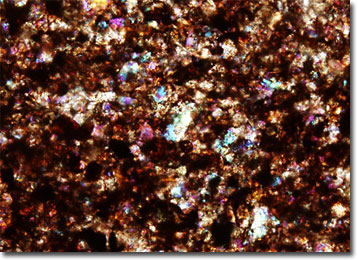Polarized Light Microscopy Digital Image Gallery
Ferruginous Shale
Shale is a kind of rock formed from the accumulation and hardening of fine-grained sediments and clays, often in quiet bodies of water. Economically important, shales have been utilized for a variety of purposes throughout history, especially as a source of fuels and of valuable ores.

Relatively porous and soft, shale is able to readily take up and release minerals and organic material. Thus, the composition of shales is quite various, heavily depending on the surrounding environment. Ferruginous shale is a type of shale that is rich in iron. The rock typically exhibits a reddish hue if the iron present is ferric or a green tint if the iron is ferrous. Dark gray or black shale, however, often results from the presence of significant amounts of organic matter. Some organically rich shales also contain kerogen, a chemically complex mixture of hydrocarbons that yields oil when heated. These oil shales have periodically been utilized as a fuel source, but are not yet as practically useful as crude oil deposits.
One of the most famous shale deposits in the world is the Burgess Shale, which was discovered in 1909 by Charles D. Walcott of the Smithsonian Institution. Despite the fact that Walcott recognized the presence of fossils in the deposit, his find initially received little attention. However, in the 1980s, an investigation carried out by a group of scientists from the University of Cambridge revealed the true value of the shale, which is located in a region of the Canadian Rocky Mountains called the Burgess Pass. What the research group discovered was that the Burgess Shale holds a diverse array of animal fossils, many of which derive from creatures that had never previously been identified. Indeed, even today the classification of these fossils remains difficult and is a matter of considerable debate since a number of the Canadian finds bear little resemblance to other known fauna.
